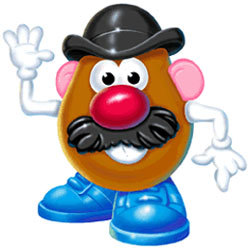
Lerner shopped the idea around to toy companies, but the concept was unpopular. World War II and its food rationing were still present in people’s memory and the use of fruits and vegetables to make toys was considered too wasteful. No toy company would buy the invention.
After several years of trying to sell the toy, Lerner finally convinced a food company to distribute the plastic parts as premiums in cereal boxes. He sold the idea for $5,000. In 1951, Lerner showed the idea to textile manufacturers Henry and Merrill Hassenfeld, who conducted a small school supply and toy business called Hassenfeld Bros. (that later became Hasbro). The brothers paid the cereal company $2,000 to stop production and $5,000 for the rights. Lerner was offered an advance of $500 and a 5% royalty on every kit sold. The toy was named Mr. Potato Head and went into production and has never stopped being made since.
Mr. Potato Head was first sold in 1952. The original toy cost 98 cents, and contained hands, feet, ears, two mouths, two pairs of eyes, four noses, three hats, eyeglasses, a pipe, and 8 felt pieces resembling facial hair. There was no potato body in the kit. Parents had to supply the potatoes to make the finished product.
On April 30, 1952, Mr. Potato Head was the first toy advertised on television directly to children. Before, all advertising about toys had been directed toward parents. Over one million kits were sold in the first year. In 1953, Mrs. Potato Head was added, and soon after, Brother Spud and Sister Yam completed the Potato Head family with accessories reflecting the affluence of the fifties that included a car, a boat trailer, a kitchen set, a stroller, and pets called Spud-ettes.
It wasn’t until 1964 that the boxed Mr. Potato Head started to contain a plastic potato to insert the face and body pieces into.
In 1975, like other fat Americans, the plastic potato and accessories doubled in size. This was done mainly because new toy child safety regulations required toy pieces big enough to prevent being a choking hazard. The change in size also increased the market to younger children, enabling them to play and attach the facial pieces easily.
No comments:
Post a Comment